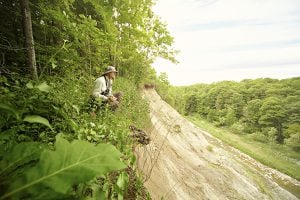
Science & Tech
20 Canadian innovations you should know about
Celebrating Canadian Innovation Week 2023 by spotlighting the people and organizations designing a better future
- 3327 words
- 14 minutes
Travel
Astronomer and author Alan Dyer shares his favourite places in Alberta and Saskatchewan to escape the city lights and take in the wonders of the night sky

For Canadians looking to beat the intense summer heat, starry nights are more enticing than ever. And with the days getting shorter, it’s the perfect time to plan an escape from the city lights and take in the wonders of the night sky — think the Milky Way, northern lights and, if you’re lucky, maybe a shooting star or two.
Alan Dyer is an Alberta-based astronomer, astrophotographer and co-author of The Backyard Astronomer’s Guide, an essential reference that delves into everything from gear to tips and techniques for observing solar and lunar eclipses. Ahead of the fall release of the book’s fourth edition, we asked Dyer to share his favourite places in Western Canada for stargazing and astrophotography. Here are his top picks for prime viewing spots in Alberta and Saskatchewan that are free of light pollution and obstructions — and also happen to be unrivalled in natural beauty.

Together with Montana’s Glacier National Park to the south, Waterton Lakes is an official dark-sky preserve (in which light pollution is greatly reduced or eliminated). With the exception of the lights around the Waterton Lakes townsite, it’s a very dark place. The surrounding area is open and provides a good view of the sky. The park will likely resume their own stargazing programs once COVID-19 restrictions ease, but there’s also a private tour group I helped start called Dark Sky Guides that will take you out for night sky hikes and stargazing sessions. As an amateur stargazer, you’re often better to go out with a guide who can point out some of the amazing features of the night sky.

There are many companies similar to Dark Sky Guides in Jasper, which is another dark-sky preserve. There’s some disruptive light in the Jasper townsite and at certain populated spots on the Icefields Parkway, but other than that, there aren’t a lot of lights around in the park itself. Jasper caters to dark sky tourists with its Dark Sky Festival every October, featuring speakers, programs and stargazing sessions, along with the planetarium there. There are many big open areas around the Jasper townsite to set up a telescope and stargaze by yourself or with a tour group.
View this post on Instagram
Straddling the Alberta-Saskatchewan border, Cypress Hills is a stargazer’s paradise. It was made a dark-sky preserve a number of years ago, so more than most parks, the staff are very astronomy-aware and do a lot of related programming. And, after a comet was spotted from Cypress Hills by the amateur Regina astronomer Vince Petrew, the park was guaranteed a spot on the map astronomically.
Cypress Hills is a protected, raised area that never saw glaciation. It’s like a green oasis in the midst of the plains, with beautiful lakes and wooded hills. There are great spots for night sky viewing on both sides of the provincial border, but the Saskatchewan side in particular is a hot spot for astronomy. The Saskatchewan and Regina Centres of the Royal Astronomical Society of Canada host a huge Summer Star Party in Maple Creek, Sask. every August, coinciding with the Perseid meteor shower. People come from all over to camp out in tents and RVs and there are talks and other public events. At other times of the year, depending on COVID-19 restrictions, you may be able to visit the public observatory in the park, accessed via the visitor centre in Maple Creek. In normal operating conditions, it’s open for both daytime sun observation and nighttime stargazing.
View this post on Instagram
Situated right on the Canada-U.S. border, Grasslands is a fabulously dark spot with separate East and West Units. The West Unit is near the village of Val Marie, so more services are available nearby. The East Unit is very remote but both are very, very dark. The park preserves some of the last remaining natural shortgrass prairie in North America. It’s definitely not the classic “flat” Saskatchewan landscape: there are rolling hills, prairies and badlands, buttes, and the Frenchman Valley.
Some of the best and most unique stargazing in Canada can be experienced in Grasslands and southwestern Saskatchewan in general. Even at the height of summer there’s not many people there. It really is Big Sky Country since there aren’t a lot of trees around; one spot is called Two Trees because that’s its main attraction
Galactic gazing: The better your view of the southern sky, unobstructed by trees and mountains, the better your view of the brightest and best parts of the Milky Way. It’s on prime view from July to about October.
Timing is everything: Remember that a full or gibbous moon will wash out the sky and obscure the Milky Way. Optimal viewing is during the week before and after the new moon when it’s less radiant.
Northern exposure: In Western Canada, it’s possible to catch a display of aurora borealis pretty much year-round, even on short summer nights. To see the northern lights, you should get away from any light pollution and get a good view of the northern sky with relatively few obstructions. In general, the northern lights will appear better and brighter the further north you go, so choose your stargazing destination accordingly.
Alan Dyer is the co-author of The Backyard Astronomer’s Guide, which is available for pre-order through Indigo and Amazon. He also offers workshops and tutorials via his website, amazingsky.com. He lives in Alberta.
Are you passionate about Canadian geography?
You can support Canadian Geographic in 3 ways:

Science & Tech
Celebrating Canadian Innovation Week 2023 by spotlighting the people and organizations designing a better future

Travel
The trail started with a vision to link Canada coast to coast to coast. Now fully connected, it’s charting an ambitious course for the future.

Wildlife
Canada jays thrive in the cold. The life’s work of one biologist gives us clues as to how they’ll fare in a hotter world.

Places
It’s an ambitious plan: take the traditional Parks Canada wilderness concept and plunk it in the country’s largest city. But can Toronto’s Rouge National Urban Park help balance city life with wildlife?